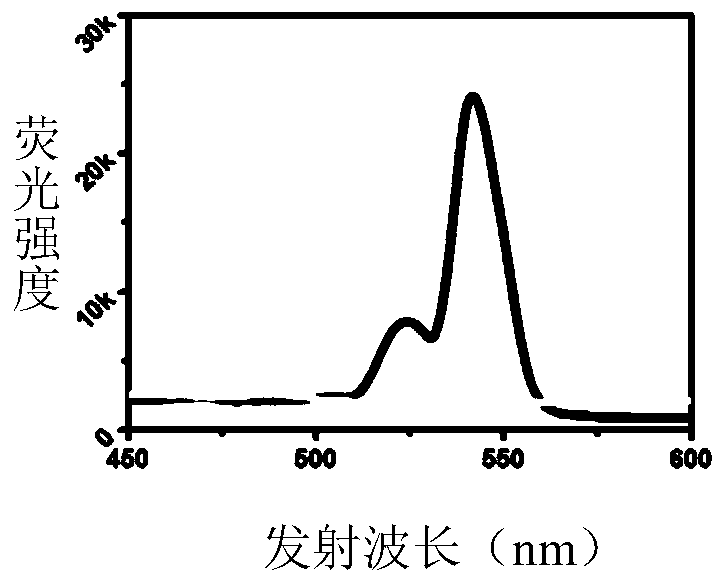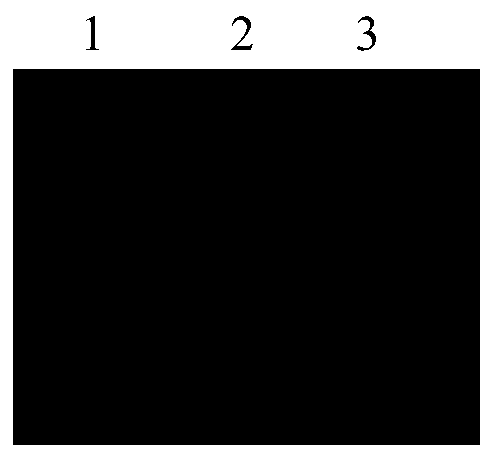Method of utilizing rare earth up-conversion fluorescent particles to mark sendai virus envelope
A technology of rare earth up-conversion and fluorescent particles, which is applied in the field of biotechnology and materials, can solve the problems of weak fluorescence of fluorescent proteins, long fusion expression cycle, and great influence on virus particle activity, and achieve high-efficiency expression
- Summary
- Abstract
- Description
- Claims
- Application Information
AI Technical Summary
Problems solved by technology
Method used
Image
Examples
Embodiment 1
[0049] Synthesis of Rare Earth Upconversion Fluorescent Particles by High Temperature Oil Phase Method
[0050] According to the mass fraction ratio, it is yttrium chloride: ytterbium chloride: erbium chloride==78:20:5 raw materials are added in the round-bottomed flask, solvent water is added to make the above-mentioned substances dissolve completely; under magnetic stirring conditions, it is heated to boiling, Until the rare earth salt solution turns into a white solid; after the water is evaporated to dryness, cool to 60°C, add oleic acid:octadecene=2:1 into a round-bottomed flask according to the volume ratio to completely dissolve the white solid; Sodium hydroxide: ammonium fluoride = 1:3, add the two, and add methanol to dissolve completely, the mass ratio of ammonium fluoride to the above-mentioned thulium chloride = 3:1; adjust the temperature to 120°C, and vacuum for 30min , through argon gas; quickly heat up to 300 ° C, and maintain the reaction for 1 h; after the en...
Embodiment 2
[0052] Synthesis of Rare Earth Upconversion Fluorescent Particles by High Temperature Oil Phase Method
[0053] According to the mass fraction ratio, it is yttrium chloride: ytterbium chloride: erbium chloride==78:20:4 raw materials are added in the round bottom flask, solvent water is added to make the above-mentioned substances dissolve completely; under magnetic stirring conditions, it is heated to boiling, Until the rare earth salt solution turns into a white solid; after the water is evaporated to dryness, cool to 60°C, add oleic acid:octadecene=2:1 into a round-bottomed flask according to the volume ratio to completely dissolve the white solid; Sodium hydroxide: ammonium fluoride = 1:3, add the two, and add methanol to dissolve completely, the mass ratio of ammonium fluoride to the above-mentioned thulium chloride = 3:1; adjust the temperature to 120°C, and vacuum for 30min , blowing argon; rapidly raising the temperature to 300° C., and maintaining the reaction for 1 h;...
Embodiment 3
[0055] Synthesis of Rare Earth Upconversion Fluorescent Particles by High Temperature Oil Phase Method
[0056] According to the mass fraction ratio, it is yttrium chloride: ytterbium chloride: erbium chloride==78:20:2 raw materials are added in the round bottom flask, solvent water is added to make the above-mentioned substances dissolve completely; under magnetic stirring conditions, be heated to boiling, Until the rare earth salt solution turns into a white solid; after the water is evaporated to dryness, cool to 60°C, add oleic acid:octadecene=2:1 into a round-bottomed flask according to the volume ratio to completely dissolve the white solid; Sodium hydroxide: ammonium fluoride = 1:3, add the two, and add methanol to dissolve completely, the mass ratio of ammonium fluoride to the above-mentioned thulium chloride = 3:1; adjust the temperature to 120°C, and vacuum for 30min , blowing argon; rapidly raising the temperature to 300° C., and maintaining the reaction for 1 h; af...
PUM
 Login to View More
Login to View More Abstract
Description
Claims
Application Information
 Login to View More
Login to View More - R&D
- Intellectual Property
- Life Sciences
- Materials
- Tech Scout
- Unparalleled Data Quality
- Higher Quality Content
- 60% Fewer Hallucinations
Browse by: Latest US Patents, China's latest patents, Technical Efficacy Thesaurus, Application Domain, Technology Topic, Popular Technical Reports.
© 2025 PatSnap. All rights reserved.Legal|Privacy policy|Modern Slavery Act Transparency Statement|Sitemap|About US| Contact US: help@patsnap.com



